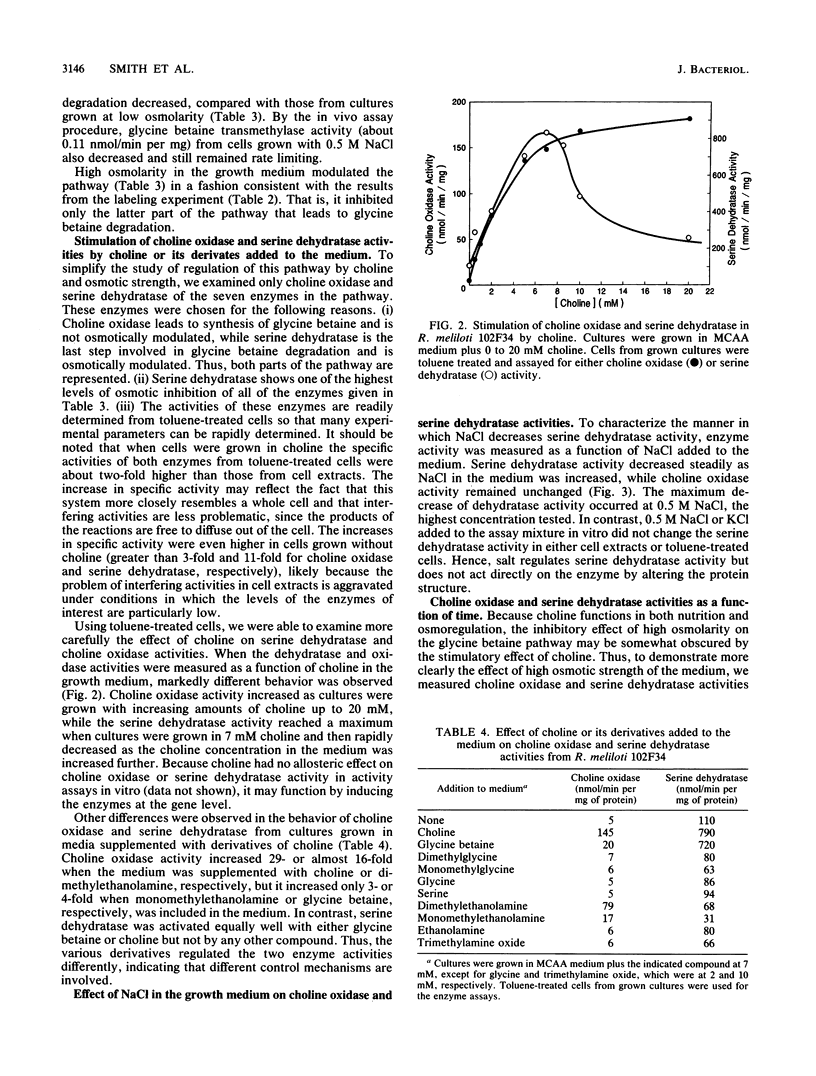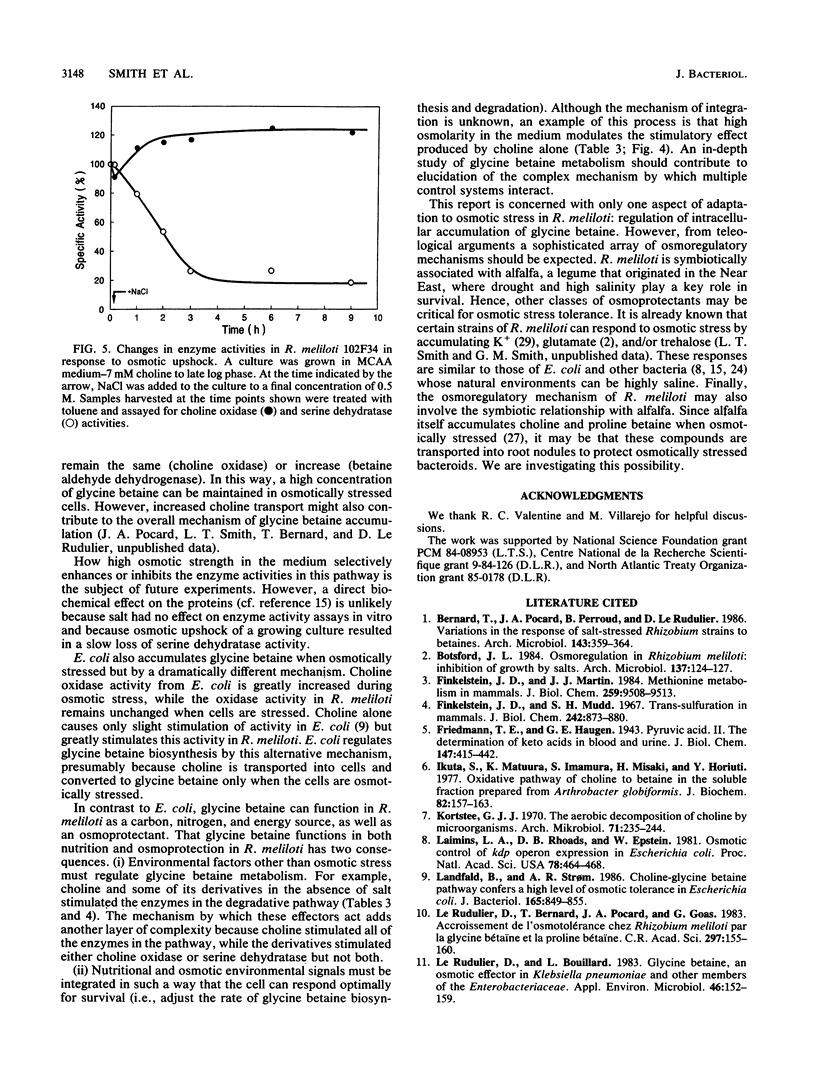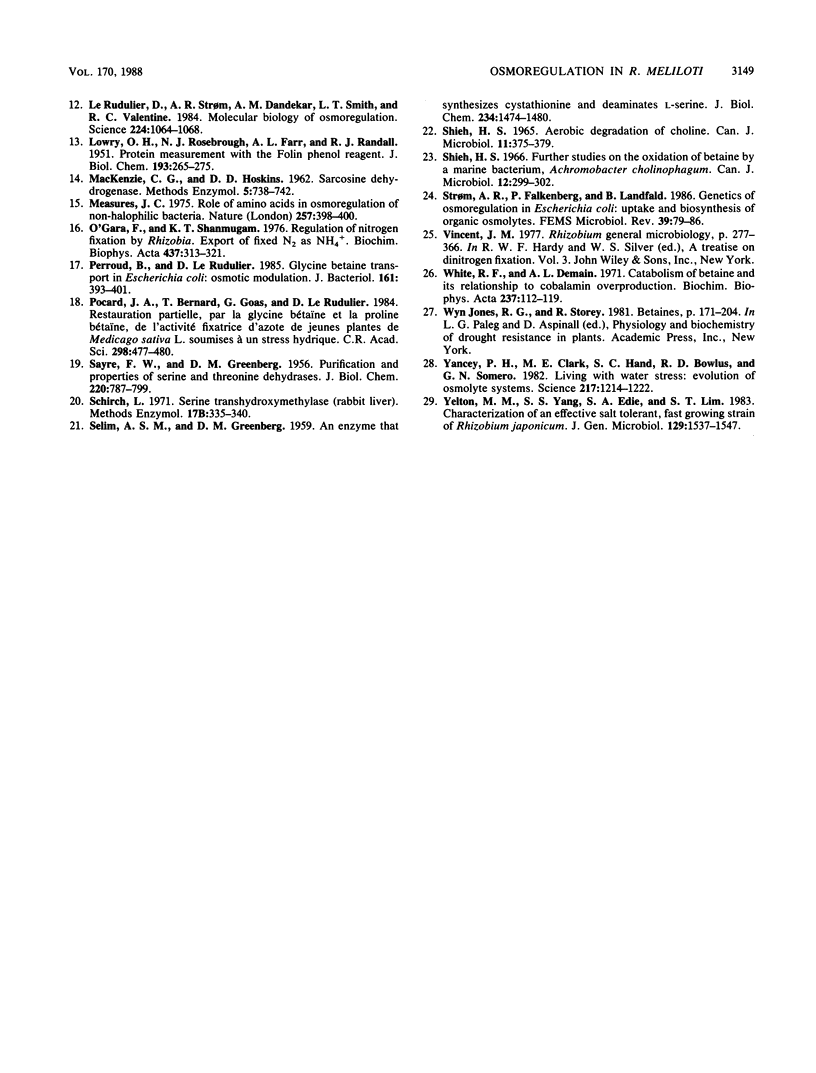Abstract
Intracellular accumulation of glycine betaine has been shown to confer an enhanced level of osmotic stress tolerance in Rhizobium meliloti. In this study, we used a physiological approach to investigate the mechanism by which glycine betaine is accumulated in osmotically stressed R. meliloti. Results from growth experiments, 14C labeling of intermediates, and enzyme activity assays are presented. The results provide evidence for the pathway of biosynthesis and degradation of glycine betaine and the osmotic effects on this pathway. High osmolarity in the medium decreased the activities of the enzymes involved in the degradation of glycine betaine but not those of enzymes that lead to its biosynthesis from choline. Thus, the concentration of the osmoprotectant glycine betaine is increased in stressed cells. This report demonstrates the ability of the osmolarity of the growth medium to regulate the use of glycine betaine as a carbon and nitrogen source or as an osmoprotectant. The mechanisms of osmoregulation in R. meliloti and Escherichia coli are compared.
Full text
PDF







Selected References
These references are in PubMed. This may not be the complete list of references from this article.
- Finkelstein J. D., Martin J. J. Methionine metabolism in mammals. Distribution of homocysteine between competing pathways. J Biol Chem. 1984 Aug 10;259(15):9508–9513. [PubMed] [Google Scholar]
- Finkelstein J. D., Mudd S. H. Trans-sulfuration in mammals. The methionine-sparing effect of cystine. J Biol Chem. 1967 Mar 10;242(5):873–880. [PubMed] [Google Scholar]
- Ikuta S., Matuura K., Imamura S., Misaki H., Horiuti Y. Oxidative pathway of choline to betaine in the soluble fraction prepared from Arthrobacter globiformis. J Biochem. 1977 Jul;82(1):157–163. doi: 10.1093/oxfordjournals.jbchem.a131664. [DOI] [PubMed] [Google Scholar]
- Kortstee G. J. The aerobic decomposition of choline by microorganisms. I. The ability of aerobic organisms, particularly coryneform bacteria, to utilize choline as the sole carbon and nitrogen source. Arch Mikrobiol. 1970;71(3):235–244. [PubMed] [Google Scholar]
- LOWRY O. H., ROSEBROUGH N. J., FARR A. L., RANDALL R. J. Protein measurement with the Folin phenol reagent. J Biol Chem. 1951 Nov;193(1):265–275. [PubMed] [Google Scholar]
- Laimins L. A., Rhoads D. B., Epstein W. Osmotic control of kdp operon expression in Escherichia coli. Proc Natl Acad Sci U S A. 1981 Jan;78(1):464–468. doi: 10.1073/pnas.78.1.464. [DOI] [PMC free article] [PubMed] [Google Scholar]
- Landfald B., Strøm A. R. Choline-glycine betaine pathway confers a high level of osmotic tolerance in Escherichia coli. J Bacteriol. 1986 Mar;165(3):849–855. doi: 10.1128/jb.165.3.849-855.1986. [DOI] [PMC free article] [PubMed] [Google Scholar]
- Le Rudulier D., Bouillard L. Glycine betaine, an osmotic effector in Klebsiella pneumoniae and other members of the Enterobacteriaceae. Appl Environ Microbiol. 1983 Jul;46(1):152–159. doi: 10.1128/aem.46.1.152-159.1983. [DOI] [PMC free article] [PubMed] [Google Scholar]
- Le Rudulier D., Strom A. R., Dandekar A. M., Smith L. T., Valentine R. C. Molecular biology of osmoregulation. Science. 1984 Jun 8;224(4653):1064–1068. doi: 10.1126/science.224.4653.1064. [DOI] [PubMed] [Google Scholar]
- Measures J. C. Role of amino acids in osmoregulation of non-halophilic bacteria. Nature. 1975 Oct 2;257(5525):398–400. doi: 10.1038/257398a0. [DOI] [PubMed] [Google Scholar]
- O'Gara F., Shanmugam K. T. Regulation of nitrogen fixation by Rhizobia. Export of fixed N2 as NH+4. Biochim Biophys Acta. 1976 Jul 21;437(2):313–321. doi: 10.1016/0304-4165(76)90001-5. [DOI] [PubMed] [Google Scholar]
- Perroud B., Le Rudulier D. Glycine betaine transport in Escherichia coli: osmotic modulation. J Bacteriol. 1985 Jan;161(1):393–401. doi: 10.1128/jb.161.1.393-401.1985. [DOI] [PMC free article] [PubMed] [Google Scholar]
- SAYRE F. W., GREENBERG D. M. Purification and properties of serine and threonine dehydrases. J Biol Chem. 1956 Jun;220(2):787–799. [PubMed] [Google Scholar]
- SELIM A. S., GREENBERG D. M. An enzyme that synthesizes cystathionine and deaminates L-serine. J Biol Chem. 1959 Jun;234(6):1474–1480. [PubMed] [Google Scholar]
- SHIEH H. S. AEROBIC DEGRADATION OF CHOLINE. II. SOME PROPERTIES OF WHOLE CELLS AND CELL-FREE EXTRACTS OF ACHROMOBACTER CHOLINOPHAGUM. Can J Microbiol. 1965 Apr;11:375–379. doi: 10.1139/m65-045. [DOI] [PubMed] [Google Scholar]
- Shieh H. S. Further studies on the oxidation of betaine by a marine bacterium, Achromobacter cholinophagum. Can J Microbiol. 1966 Apr;12(2):299–302. doi: 10.1139/m66-040. [DOI] [PubMed] [Google Scholar]
- White R. F., Demain A. L. Catabolism of betaine and its relationship to cobalamin overproduction. Biochim Biophys Acta. 1971 Apr 20;237(1):112–119. doi: 10.1016/0304-4165(71)90036-5. [DOI] [PubMed] [Google Scholar]
- Yancey P. H., Clark M. E., Hand S. C., Bowlus R. D., Somero G. N. Living with water stress: evolution of osmolyte systems. Science. 1982 Sep 24;217(4566):1214–1222. doi: 10.1126/science.7112124. [DOI] [PubMed] [Google Scholar]


